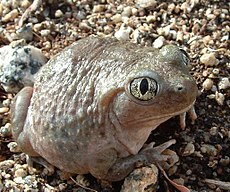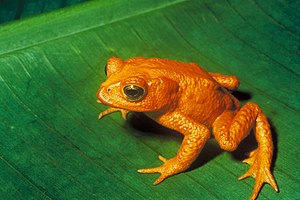Amphibian
This article includes a list of references, related reading, or external links, but its sources remain unclear because it lacks inline citations. (July 2007) |
| Amphibians | |
|---|---|

| |
| Western Spadefoot Toad, Spea hammondii | |
| Scientific classification | |
| Kingdom: | |
| Phylum: | |
| Subphylum: | |
| Class: | Amphibia Linnaeus, 1758
|
| Subclasses and Orders | |
|
Order Temnospondyli - extinct | |
Amphibians (class Amphibia; from Greek αμφις "both" and βιος "life") are a taxon of animals that include all living tetrapods (four-legged vertebrates) that do not have amniotic eggs, are ectothermic (term for the animals whose body heat is regulated by the external environment; previously known as cold-blooded), and generally spend part of their time on land. Most amphibians do not have the adaptations to an entirely terrestrial existence found in most other modern tetrapods (amniotes). There are around 6,000 described, living species of amphibians. The study of amphibians and reptiles is known as herpetology. Amphibians are able to breathe through their skin.
Classification
Traditionally the amphibians have included all tetrapods that are not amniotes. They are divided into three subclasses:
- Subclass Labyrinthodontia (diverse Paleozoic and early Mesozoic group)
- Subclass Lepospondyli (small Paleozoic group)
- Subclass Lissamphibia (frogs, salamanders, etc)
Of these only the last includes recent species.
With the cladistic revolution, this classification has been modified, and the Labyrinthodontia discarded as being a paraphyletic group without unique defining features apart from shared primitive characteristics. Classification varies according to the preferred phylogeny of the author, and whether they use a stem-based or node-based classification. Generally amphibians are defined as the group that includes the common ancestors of all living amphibians (frogs, salamanders, etc) and all their descendants. This may also include extinct groups like the temnospondyls (traditionally placed in the disbanded subclass "labyrinthodontia"), and the Lepospondyls. This means that there are a now large number of basal Devonian and Carboniferous tetrapod groups, described as "amphibians" in earlier books, that are no longer placed in the formal Amphibia.

All recent amphibians are included in the Lissamphibia, which is usually considered a clade (which means that it is thought that all Lissamphibians evolved from a common ancestor apart from other extinct groups), although it has also been suggested also that salamanders arose separately from a temnospondyl-like ancestor (Carroll, 2007).
Authorities also disagree on whether Salientia is a Superorder that includes the order Anura, or whether Anura is a sub-order of the order Salientia. In effect Salientia includes all the Anura plus a single Triassic proto-frog species, Triadobatrachus. Practical considerations seem to favour using the former arrangement now.
The Lissamphibia are traditionally divided into three orders, but an extinct salamander-like group, the Albanerpetontidae, is now considered in addition to the other three groups.
- Family Albanerpetontidae - Jurassic to Miocene (extinct)
- Superorder Salientia
- Triadobatrachus (Triassic)
- Order Anura (frogs and toads): Jurassic to recent - 5,362 recent species
- Order Caudata or Urodela (salamanders): Jurassic to recent - 556 recent species
- Order Gymnophiona or Apoda (caecilians): Jurassic to recent - 173 recent species
Systems
Reproductive

For the purpose of reproduction most amphibians are bound to fresh water. A few tolerate brackish water, but there are no true seawater amphibians. Several hundred frog species in adaptive radiations (e.g., Eleutherodactylus, the Pacific Platymantines, the Australo-Papuan microhylids, and many other tropical frogs), however, do not need any water whatsoever. They reproduce via direct development, an ecological and evolutionary adaptation that has allowed them to be completely independent from free-standing water. Almost all of these frogs live in wet tropical rainforests and their eggs hatch directly into miniature versions of the adult, passing through the tadpole stage within the egg. Several species have also adapted to arid and semi-arid environments, but most of them still need water to lay their eggs. Symbiosis with single celled algae that lives in the jelly-like layer of the eggs has evolved several times. The larvae (tadpoles or polliwogs) breathe with exterior gills. After hatching, they start to transform gradually into the adult's appearance. This process is called metamorphosis. Typically, the animals then leave the water and become terrestrial adults, but there are many interesting exceptions to this general way of reproduction.
The most obvious part of the amphibian metamorphosis is the formation of four legs in order to support the body on land. But there are several other changes:
- The gills are replaced by other respiratory organs, i.e., lungs.
- The skin changes and develops glands to avoid dehydration.
- The eyes develop eyelids and adapt to vision outside the water.
- An eardrum is developed to lock the middle ear.
- In frogs and toads, the tail disappears.
Amphibian conservation

Dramatic declines in amphibian populations, including population crashes and mass localized extinction, have been noted in the past two decades from locations all over the world, and amphibian declines are thus perceived as one of the most critical threats to global biodiversity. A number of causes are believed to be involved, including habitat destruction and modification, over-exploitation, pollution, introduced species, climate change, destruction of the ozone layer (ultraviolet radiation has shown to be especially damaging to the skin, eyes, and eggs of amphibians), and diseases like chytridiomycosis. However, many of the causes of amphibian declines are still poorly understood, and amphibian declines are currently a topic of much ongoing research.
References
- Carroll, Robert L. (1988). Vertebrate Paleontology and Evolution. New York: W.H. Freeman & Co.
- Duellman, William E. (1994). Biology of Amphibians. Johns Hopkins University Press. ISBN 978-0801847806.
{{cite book}}: Unknown parameter|coauthors=ignored (|author=suggested) (help) - Frost, Darrel R. (2006). "The Amphibian Tree of Life". Bulletin of the American Museum of Natural History. 297: 1–291.
{{cite journal}}: Unknown parameter|coauthors=ignored (|author=suggested) (help); Unknown parameter|month=ignored (help) - Pounds, J. Alan (2006). "Widespread amphibian extinctions from epidemic disease driven by global warming". Nature. 439: 161–167. doi:10.1038/nature04246.
{{cite journal}}: Unknown parameter|coauthors=ignored (|author=suggested) (help); Unknown parameter|month=ignored (help) - San Mauro, Diego (2005). "Initial diversification of living amphibians predated the breakup of Pangaea". American Naturalist. 165: 590–599.
{{cite journal}}: Unknown parameter|coauthors=ignored (|author=suggested) (help); Unknown parameter|month=ignored (help) - Solomon Berg Martin, Biology
- Stuart, Simon N. (2004). "Status and trends of amphibian declines and extinctions worldwide". Science. 306 (5702): 1783–1786. doi:10.1126/science.1103538.
{{cite journal}}: Unknown parameter|coauthors=ignored (|author=suggested) (help); Unknown parameter|month=ignored (help)
See also
- Chytridiomycosis
- Fishapods
- Frog zoology
- List of amphibians by region
- Prehistoric amphibian
- Sleep in nonhumans
- Tetrapod
External links
- American Museum of Natural History: Department of herpetology
- The Global Amphibian Assessment
- AmphibiaWeb
- Amphibians of central Europe
- USGS--Online Guide for the Identification of Amphibians in North America north of Mexico
- Herpetological Conservation and Biology
- General amphibian biology information - Living UnderWorld
Template:Link FA These show different symbols of how to give names to amphibians and they were used most of the time
